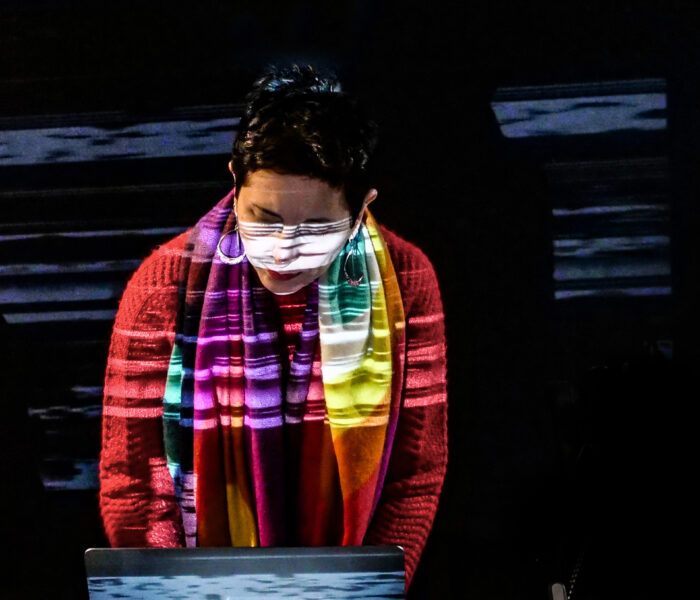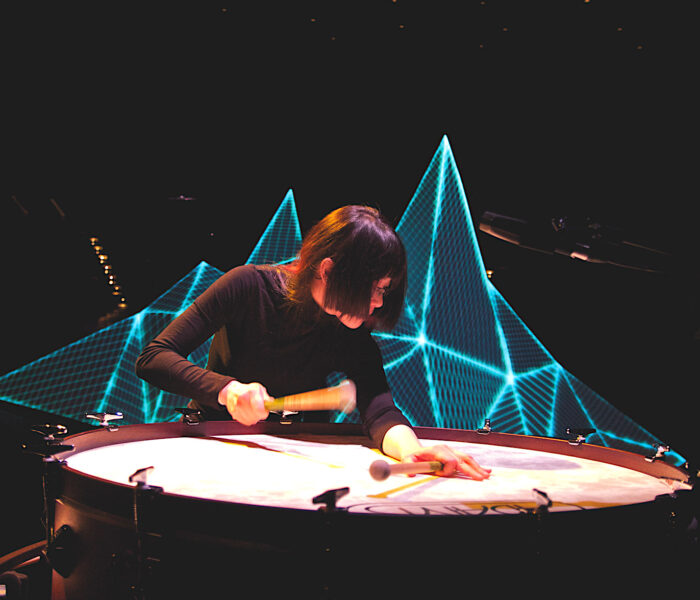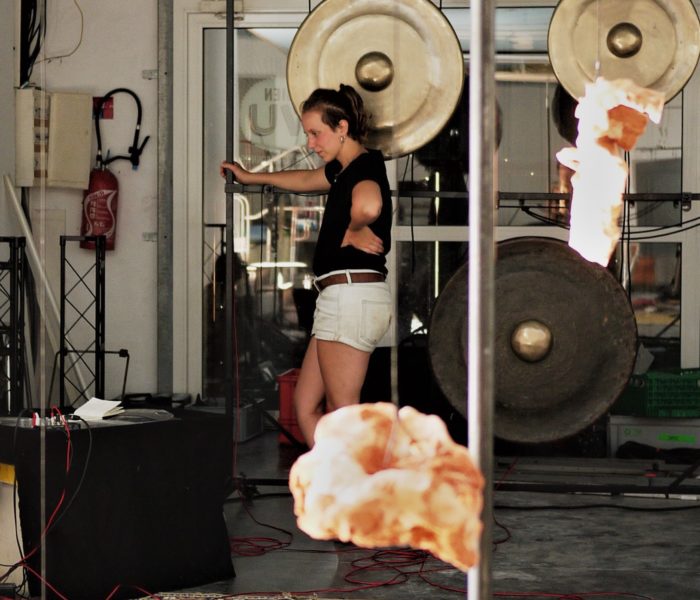La Philharmonie de Paris consacre, au sein du Musée de la musique, une exposition à l’œuvre pionnière de Iannis Xenakis (1922-2001) à l’occasion du centenaire de sa naissance, parachevant ainsi une trilogie sur le répertoire contemporain après « Pierre Boulez » en 2015 et l’ouverture du Studio Pierre Henry en 2019.
“Adhérer à des pactes militaires ou à des conventions commerciales ne concerne pas directement les peuples qui sont entraînés par des déterminismes souvent monstrueux. Par contre, créer des filaments artistiques reliant les populations de tous les pays, c’est établir un nouveau contact direct, par-dessus les langues, les intérêts, les civilisations, les races, les cultures locales. Cela est maintenant possible à condition que la forme de cet art produise l’étincelle du contact immédiat.“
Iannis Xenakis , Polytope Mondial (réseau intercontinental d’actions de lumière et de son), 1974
Le titre de l’exposition du Musée de la musique « Révolutions Xenakis » donne immédiatement le ton. L’enjeu de ce bref et dense parcours de 400m2 est bien de démontrer en quoi la combinaison de la vie et l’œuvre du compositeur d’origine grecque naturalisé français est un modèle de radicalité esthétique et politique profondément ancré dans les avant-gardes architecturale et musicale de la deuxième partie du 20ème siècle. Grâce au trialogue fécond entre Thierry Maniguet, conservateur chargé des collections du 20ème siècle, Mâkhi Xenakis, fille et biographe du compositeur, tous deux chargés du commissariat, et Jean-Michel Wilmotte, architecte et designer, chargé de la scénographie, l’exposition réussit, de manière synthétique voire fulgurante, le tour de force d’aborder les facettes primordiales de l’œuvre et dessiner un portrait historique, intime et audiovisuel de Iannis Xenakis.

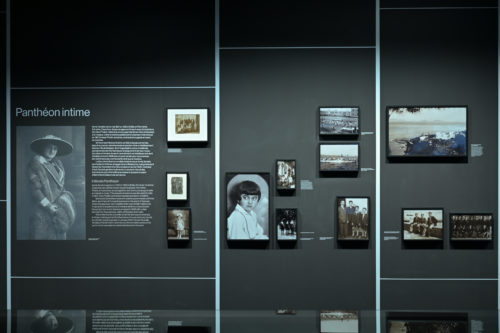
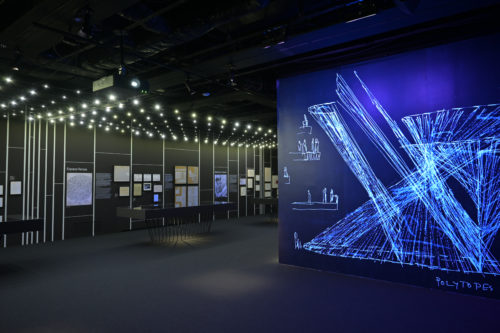
Archives et fétiches à l’appui, la première section de l’exposition, Panthéon intime, revient sur les événements clefs de la jeunesse de Xenakis, comme autant de conditionnements sublimés par son œuvre future. Né en Roumanie de parents grecs, en 1922 donc, à moins que ce ne soit en 1921 comme un deuxième passeport présenté en vitrine l’atteste, à moins encore que ce ne soit « vingt-cinq siècles trop tard » comme il l’a écrit, Xenakis porte à la fois l’empreinte, la cicatrice même, des bouleversements historiques que le siècle dernier a traversés, et l’héritage philosophique et mystique de la culture grecque antique. Après une enfance assombrie par la mort prématurée de sa mère qui lui a enseigné le piano et dont on lui dit qu’il est la réincarnation, frappé par la Cinquième Symphonie de Beethoven « comme une apocalypse », passionné par les sciences et les mathématiques, il commence des études d’ingénieur à l’École Polytechnique d’Athènes interrompues par la Deuxième Guerre mondiale. Il s’embarque alors dans la résistance contre les Nazis, d’abord aux côtés des nationalistes puis avec les communistes. En 1945, lors de la guerre civile opposant royalistes et communistes, aux commandes de la compagnie Lord Byron, il est défiguré par un éclat d’obus tiré par le camp anglais, perdant l’usage de l’œil gauche. Hôpital, prison, persécution politique, exil, condamnation à mort par contumace. Xenakis se réfugie en France, est engagé par le Corbusier comme ingénieur et suit en parallèle les cours de composition d’Olivier Messiaen, de véritables leçons d’ornithologie qu’il reporte minutieusement dans des carnets à spirales rouges. L’enseignement anti-académique de Messiaen, qui invite à écouter et composer et surtout à trouver et utiliser des sons ailleurs que dans la musique, le marque à jamais. Il compose sa première pièce Metastaseis en 1954 qui, constituée de masses sonores construites grâce aux mathématiques, ces fameux glissandi, porte « les souvenirs des balles tirées pendant la Résistance ».

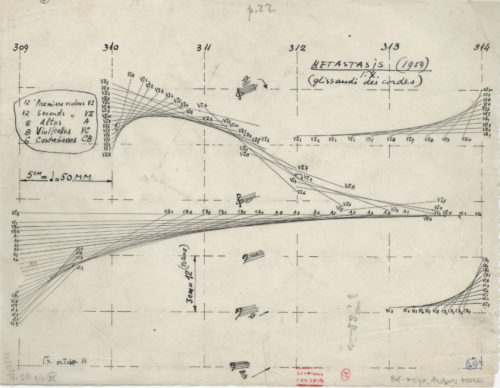

Les fondements biographiques étant posés, l’exposition se poursuit sous le double patronage de la musique et l’architecture, car, selon les commissaires, « ingénieur, architecte, compositeur, mathématicien, informaticien, Iannis Xenakis ne fut pas l’un puis l’autre, ni l’un sans l’autre. Alliage entre arts et sciences, son œuvre musicale et architecturale est le reflet de dynamiques complémentaires. » Ainsi, trône en majesté la maquette originale du Pavillon Philips, attraction éphémère grandiose et avant-gardiste « aux parois en paraboloïdes hyperboliques » conçue par Xenakis sous l’égide du Corbusier pour l’Exposition Universelle de 1958 à Bruxelles, dans lequel un poème électronique d’Edgar Varèse est diffusé sur des « chemins de sons » de 325 haut-parleurs au cours d’un spectacle d’images et de lumières. Pour recréer justement les conditions d’écoute collective des Polytopes de Xenakis, ces installations immersives et multimédias pionnières, et donner ainsi au public un extrait de sensation d’« inouï », l’espace d’exposition est, à intervalle de trente minutes, court-circuité par la diffusion générale du son de l’accelerando de La Légende d’Eer (1977), une composition aussi technologique par son format qu’antique par son sujet, doublée de flashs lumineux et d’apparitions fugaces au mur de dessins d’architecture.

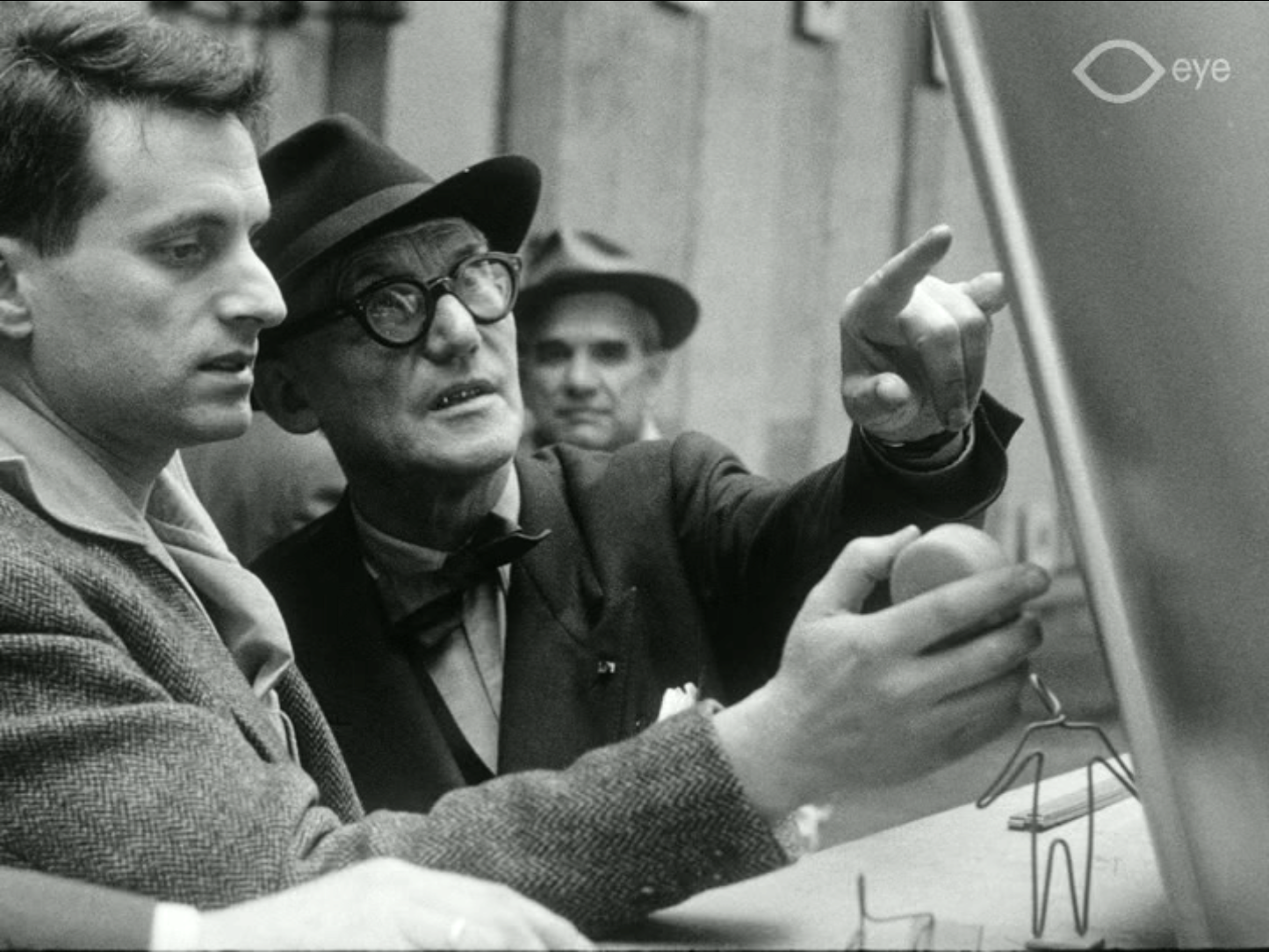
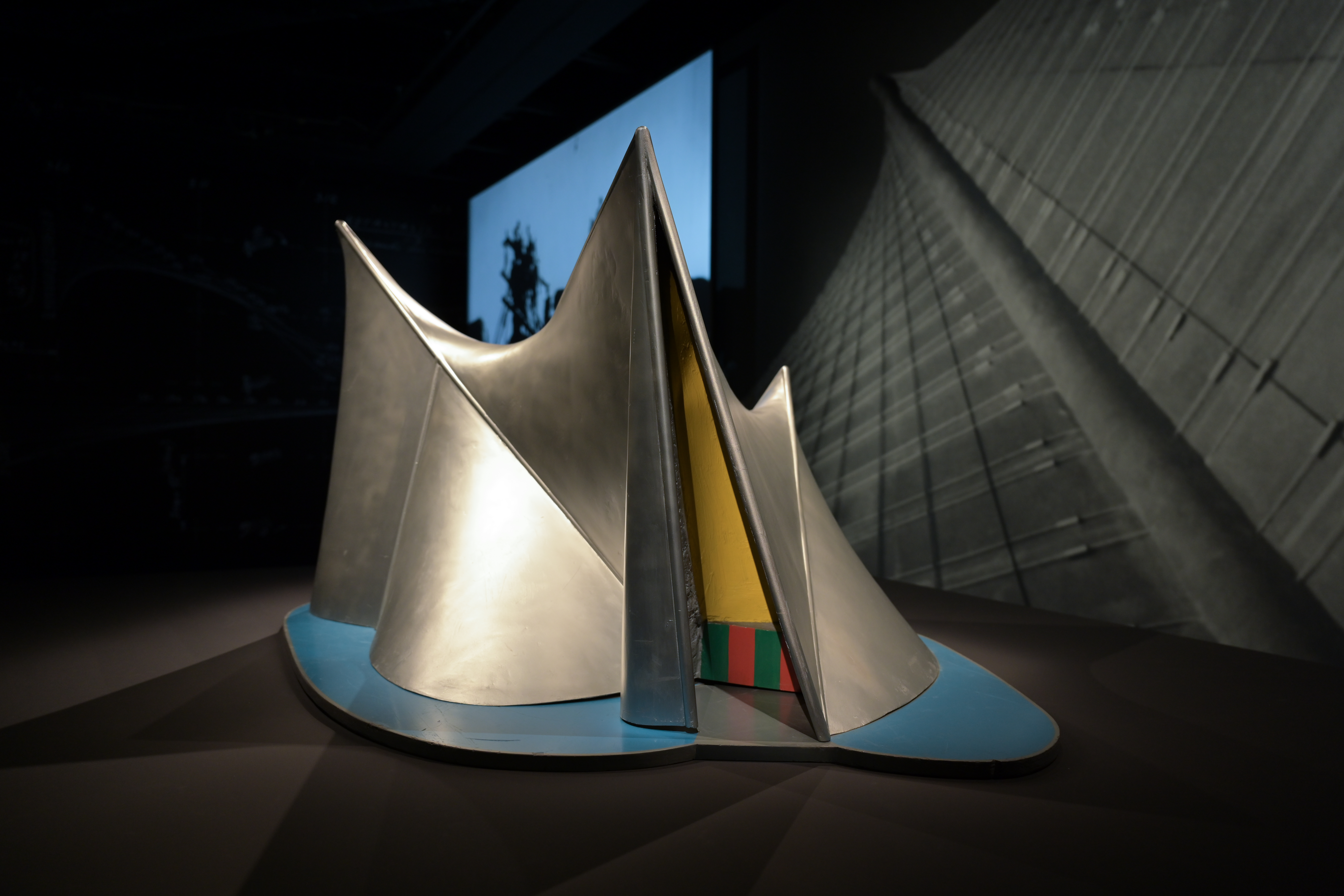
Rebuté par la pompe de l’opéra autant que par la musique sérielle dont il juge les compositions par trop limitées, admirateur dès ses débuts de la musique concrète et acousmatique de Pierre Schaeffer et de Pierre Henry, familier « des musiques extra-européennes de l’Inde, du Laos, du Vietnam, de Java, de Chine et du Japon », Xenakis développe une œuvre singulière et expérimentale qui échappe à une classification musicologique étroite par mouvements et dont la portée éminemment originale est d’emblée reconnue. Le musicologue Makis Solomos rapporte qu’en mai 1968, les étudiants du Conservatoire de Paris inscrivent sur les noms des salles de classes : “Xenakis, pas Gounod!”…
Mais de quoi donc les révolutions voire les utopies de Xenakis sont-elles faites ? D’abord, de ses alliages interdisciplinaires. L’apport des mathématiques sous-tend ses compositions musicales, tout comme des principes architecturaux inspirent ses concepts compositionnels. À ce titre, toujours dans un souci de démonstration visuelle, l’exposition met en parallèle le dessin de la façade du convent de la Tourette réalisé dans le bureau du Corbusier avec les partitions musicales d’Achorripsis (1956), tout comme les parois du Pavillon Philips avec les glissandi de Metastaseis (1953). Puis, poursuivant la réflexion amorcée au Pavillon Philips, il est surtout l’un des premiers à s’intéresser à la diffusion spatialisée du son en réalisant ses Polytopes qui métabolisent l’ensemble de ses recherches sonores et visuelles sur la part active du décor (ou de l’espace) dans la création et la réception de l’œuvre. Après le Polytope créé pour le pavillon français de l’Exposition universelle de 1967 à Montréal, premier du genre, l’exposition met en avant le Diatope de Beaubourg (1978), un spectacle musical entièrement automatisé conçu spécialement pour l’inauguration du Centre Pompidou, dont les vues intérieures montrent des auditeurs allongés au sol, sous des flashs scintillants de lumières, des lasers et des miroirs réflecteurs, en communion avec la musique électroacoustique. On se projette dans les années 1970 au cœur de l’utopie collective et on aurait presque souhaité revivre intensément et complètement l’expérience dans l’espace de cette exposition. Si cela n’a pas été envisagé par la Philharmonie de Paris, peut-être le Centre Pompidou aurait-il encore le temps de réinstaller le Diatope sur la piazza à l’occasion de l’année Xenakis ? Car dans le Diatope on trouve aussi des textes « véhiculant l’image d’un être humain voué à se débattre éternellement dans les abîmes d’un univers hostile et impénétrable » (Mihu Iliescu, Un éclaireur d’abîmes in Révolutions Xenakis), non sans résonance avec la violence des conflits armés qui nous cernent et nous désespèrent.



Enfin, et c’est peut-être cet aspect de l’œuvre qui résonne le plus avec la création contemporaine, Xenakis, en ingénieur à l’affût ou plutôt à la conquête des toutes nouvelles technologies, a su anticiper le tournant informatique des années 1980 en créant l’UPIC (pour Unité Polyagogique Informatique du CEMAMu). Appareil de synthèse sonore et de composition musicale, « machine dans laquelle, par la combinaison d’une table à dessin et d’un crayon électriques, d’un ordinateur et d’un haut-parleur, chacun peut composer de la musique en dessinant et en corrigeant le dessin après l’avoir écoutée », l’UPIC, visible dans les collections permanentes grâce à un exemplaire légué au Musée de la musique en 1992, est même utilisable par les visiteurs. Pédagogiquement révolutionnaire, cet outil offre une méthode de composition « accessible à tous ceux qui ignorent aussi bien l’informatique que le solfège, ou la pratique d’un instrument. » et permet ainsi de « confronter sans délai leur création et leur goût ». Pur technophile du 20ème siècle, Xenakis déclarait : « En définitive, toutes les expériences auxquelles je me suis livré au cours des dernières années me conduisent à la conviction que l’avenir de la musique réside dans le progrès de la technologie moderne. Celle-ci fera évoluer aussi bien la création que l’écoute de la musique. »
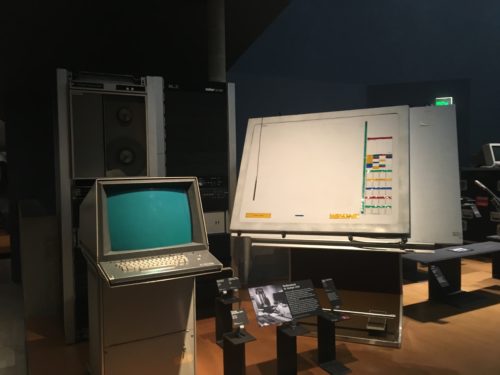
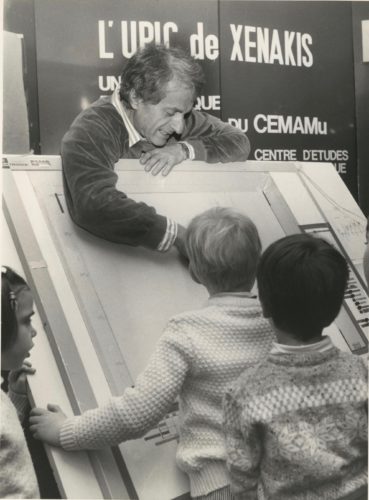

En composant un portrait du compositeur aussi sensible qu’historique et en offrant de stimulants repères, « Révolutions Xenakis » réussit donc la gageure en un bref espace-temps de faire scintiller visuellement l’œuvre de Xenakis, mais surtout de donner l’envie de plonger dans ce catalogue de près de 150 opus, dont on n’a ici et maintenant qu’un aperçu, de surfer sur les glissandi, de s’allonger sous la voûte d’un Polytope… Je me demande justement si l’importance de l’œuvre n’aurait pas mérité l’espace d’exposition plus vaste de la Philharmonie, je me console avec le prolongement du parcours dans les collections permanentes aux étages supérieurs qui offre un accrochage d’œuvres d’art cinétique et surtout avec les événements live du 17 au 20 mars. Et puis je me prends à rêver à la possibilité de la création du Polytope mondial, projet de réseau intercontinental d’actions de lumière et de son, laissé inachevé par Xenakis, peut-être même déjà dans les tuyaux d’une coopérative d’institutions en Grèce, au Mexique et au Japon à l’occasion du bicentenaire en 2122 …
Tristan Bera



)
